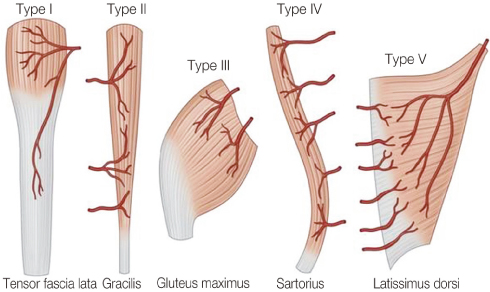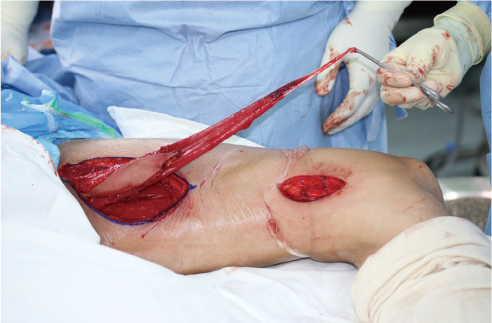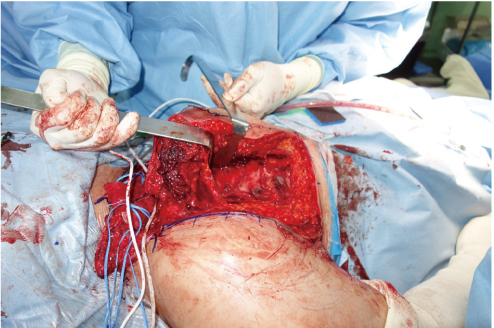J Korean Soc Surg Hand.
2017 Sep;22(3):165-173. 10.12790/jkssh.2017.22.3.165.
Free Functioning Muscle Transfer in Brachial Plexus Injury
- Affiliations
-
- 1Department of Orthopedic Surgery, Changwon Hospital, Gyeongsang National University, Changwon, Korea.
- 2Department of Orthopedic Surgery, College of Medicine, The Catholic University of Korea, Suwon, Korea. jylos1@gmail.com
- KMID: 2391213
- DOI: http://doi.org/10.12790/jkssh.2017.22.3.165
Abstract
- The free functional muscle transfer (FFMT) is the surgical procedure aimed at reconstructing defective or deteriorated muscle function by grafting free muscles including blood vessels and nerves. Since the free gracilis transfer in the facial paralysis was introduced in 1976, there have been many studies and clinical applications of the FFMT in various donor and recipient sites in brachial plexus injury, muscle ischemic contracture, muscle defect after tumor resection, congenital muscular deficit, multiple trauma. When the reconstruction of the nerve is delayed for 9 months to 1 year after the brachial plexus injury, voluntary muscle contracture is impossible even after the nerve regeneration by the irreversible degeneration of the muscles. And it is difficult to obtain adequate function even if nerve transfer or nerve transplantation is performed because the distance to be regenerated is too long. In these cases, the FFMT has been improved the functions of the upper limb in flexion or extension of the elbow, fingers. Many good clinical results of the FFMT have been reported, so the FFMT gets much interests and attentions. The essential things for the successful outcome of the surgery are the anatomical knowledge, the skilled surgical technique and the choice of patients who can meet the indications and receive long-term rehabilitation. Recent advances in surgical techniques will result in improved results of the FFMT.
MeSH Terms
Figure
Reference
-
1. Harii K, Ohmori K, Torii S. Free gracilis muscle transplantation, with microneurovascular anastomoses for the treatment of facial paralysis: a preliminary report. Plast Reconstr Surg. 1976; 57:133–143.2. Manktelow RT, McKee NH. Free muscle transplantation to provide active finger flexion. J Hand Surg Am. 1978; 3:416–426.
Article3. Ikuta Y, Yoshioka K, Tsuge K. Free muscle graft as applied to brachial plexus injury-case report and experimental study. Ann Acad Med Singapore. 1979; 8:454–458.4. Vekris MD, Beris AE, Lykissas MG, Korompilias AV, Vekris AD, Soucacos PN. Restoration of elbow function in severe brachial plexus paralysis via muscle transfers. Injury. 2008; 39:Suppl 3. S15–S22.
Article5. Stevanovic M, Sharpe F. Functional free muscle transfer for upper extremity reconstruction. Plast Reconstr Surg. 2014; 134:257e–274e.
Article6. Wechselberger G, Hussl H, Strickner N, Pulzl P, Schoeller T. Restoration of elbow flexion after brachial plexus injury by free functional rectus femoris muscle transfer. J Plast Reconstr Aesthet Surg. 2009; 62:e1–e5.
Article7. Wolff KD, Grundmann A. The free vastus lateralis flap: an anatomic study with case reports. Plast Reconstr Surg. 1992; 89:469–475.8. Grinsell D, Yue BY. The functional free innervated medial gastrocnemius flap. J Reconstr Microsurg. 2014; 30:451–456.
Article9. Liu XY, Ge BF, Win YM, Jing H. Free medial gastrocnemius myocutaneous flap transfer with neurovascular anastomosis to treat Volkmann's contracture of the forearm. Br J Plast Surg. 1992; 45:6–8.10. de Moraes FB, Kwae MY, da Silva RP, Porto CC, de Paiva Magalhaes D, Paulino MV. Evaluation of elbow flexion following free muscle transfer from the medial gastrocnemius or transfer from the latissimus dorsi, in cases of traumatic injury of the brachial plexus. Rev Bras Ortop. 2015; 50:660–665.
Article11. Mathes SJ, Nahai F. Classification of the vascular anatomy of muscles: experimental and clinical correlation. Plast Reconstr Surg. 1981; 67:177–187.12. Terzis JK, Kostopoulos VK. Free muscle transfer in posttraumatic plexopathies part ii: the elbow. Hand (N Y). 2010; 5:160–170.
Article13. Hattori Y, Doi K, Sakamoto S, Satbhai NG. Complete avulsion of brachial plexus with associated vascular trauma: feasibility of reconstruction using the double free muscle technique. Plast Reconstr Surg. 2013; 132:1504–1512.14. Doi K, Sakai K, Kuwata N, Ihara K, Kawai S. Double free-muscle transfer to restore prehension following complete brachial plexus avulsion. J Hand Surg Am. 1995; 20:408–414.
Article15. Barrie KA, Steinmann SP, Shin AY, Spinner RJ, Bishop AT. Gracilis free muscle transfer for restoration of function after complete brachial plexus avulsion. Neurosurg Focus. 2004; 16:E8.
Article16. Chung DC, Carver N, Wei FC. Results of functioning free muscle transplantation for elbow flexion. J Hand Surg Am. 1996; 21:1071–1077.17. Sturm JT, Perry JF Jr. Brachial plexus injuries from blunt trauma: a harbinger of vascular and thoracic injury. Ann Emerg Med. 1987; 16:404–406.18. Addosooki A, Doi K, Hattori Y, Wahegaonkar A. Role of wrist arthrodesis in patients receiving double free muscle transfers for reconstruction following complete brachial plexus paralysis. J Hand Surg Am. 2012; 37:277–281.
Article19. Giuffre JL, Bishop AT, Shin AY. Harvest of an entire gracilis muscle and tendon for use in functional muscle transfer: a novel technique. J Reconstr Microsurg. 2012; 28:349–358.
Article20. Doi K, Hattori Y, Tan SH, Dhawan V. Basic science behind functioning free muscle transplantation. Clin Plast Surg. 2002; 29:483–495.
Article21. Maldonado AA, Romero-Brufau S, Kircher MF, Spinner RJ, Bishop AT, Shin AY. Free functioning gracilis muscle transfer for elbow flexion reconstruction after traumatic adult brachial pan-plexus injury: where is the optimal distal tendon attachment for elbow flexion? Plast Reconstr Surg. 2017; 139:128–136.22. Doi K, Muramatsu K, Hattori Y, et al. Restoration of prehension with the double free muscle technique following complete avulsion of the brachial plexus. Indications and long-term results. J Bone Joint Surg Am. 2000; 82:652–666.23. Kay S, Pinder R, Wiper J, Hart A, Jones F, Yates A. Microvascular free functioning gracilis transfer with nerve transfer to establish elbow flexion. J Plast Reconstr Aesthet Surg. 2010; 63:1142–1149.
Article24. Kovachevich R, Kircher MF, Wood CM, Spinner RJ, Bishop AT, Shin AY. Complications of intercostal nerve transfer for brachial plexus reconstruction. J Hand Surg Am. 2010; 35:1995–2000.
Article25. Zuker RM, Manktelow RT. Functioning free muscle transfers. Hand Clin. 2007; 23:57–72.
Article26. Coulet B, Boch C, Boretto J, Lazerges C, Chammas M. Free Gracilis muscle transfer to restore elbow flexion in brachial plexus injuries. Orthop Traumatol Surg Res. 2011; 97:785–792.
Article27. MacQuillan AH, Grobbelaar AO. Functional muscle transfer and the variance of reinnervating axonal load: part II. Peripheral nerves. Plast Reconstr Surg. 2008; 121:1708–1715.
Article28. Potter SM, Ferris SI. Reliability of functioning free muscle transfer and vascularized ulnar nerve grafting for elbow flexion in complete brachial plexus palsy. J Hand Surg Eur Vol. 2017; 42:693–699.
Article29. Doi K, Hattori Y, Yamazaki H, Wahegaonkar AL, Addosooki A, Watanabe M. Importance of early passive mobilization following double free gracilis muscle transfer. Plast Reconstr Surg. 2008; 121:2037–2045.
Article30. Dodakundi C, Doi K, Hattori Y, et al. Viability of the skin paddle does not predict the functional outcome in free muscle transfers with a second ischemic event: a report of three cases. J Reconstr Microsurg. 2012; 28:267–271.
Article31. Maldonado AA, Kircher MF, Spinner RJ, Bishop AT, Shin AY. Free functioning gracilis muscle transfer with and without simultaneous intercostal nerve transfer to musculocutaneous nerve for restoration of elbow flexion after traumatic adult brachial pan-plexus injury. J Hand Surg Am. 2017; 42:293.e1–293.e7.
Article





